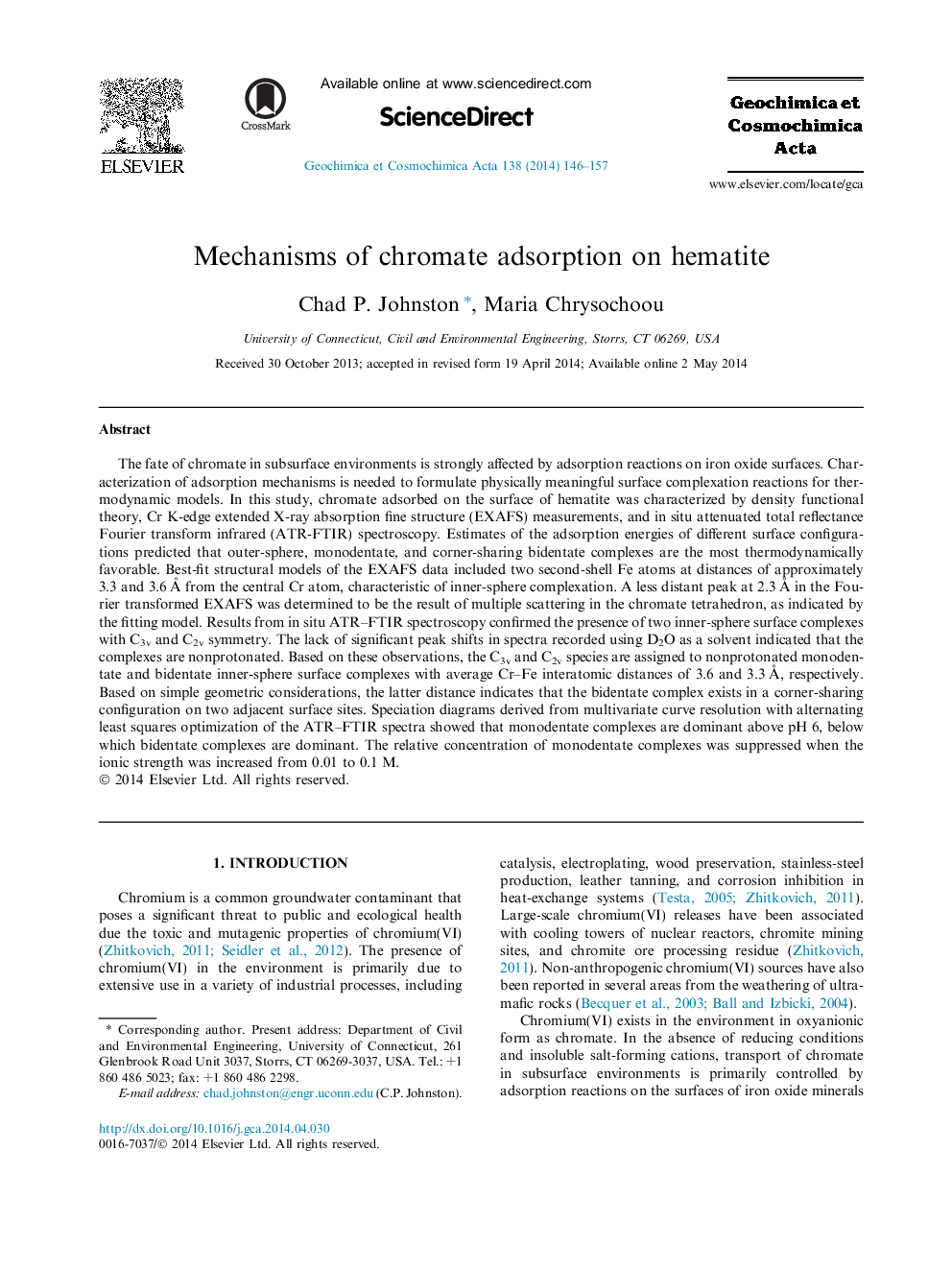| کد مقاله | کد نشریه | سال انتشار | مقاله انگلیسی | نسخه تمام متن |
|---|---|---|---|---|
| 6438569 | 1638019 | 2014 | 12 صفحه PDF | دانلود رایگان |
عنوان انگلیسی مقاله ISI
Mechanisms of chromate adsorption on hematite
ترجمه فارسی عنوان
مکانیسم جذب کرومات بر روی هماتیت
دانلود مقاله + سفارش ترجمه
دانلود مقاله ISI انگلیسی
رایگان برای ایرانیان
موضوعات مرتبط
مهندسی و علوم پایه
علوم زمین و سیارات
ژئوشیمی و پترولوژی
چکیده انگلیسی
The fate of chromate in subsurface environments is strongly affected by adsorption reactions on iron oxide surfaces. Characterization of adsorption mechanisms is needed to formulate physically meaningful surface complexation reactions for thermodynamic models. In this study, chromate adsorbed on the surface of hematite was characterized by density functional theory, Cr K-edge extended X-ray absorption fine structure (EXAFS) measurements, and in situ attenuated total reflectance Fourier transform infrared (ATR-FTIR) spectroscopy. Estimates of the adsorption energies of different surface configurations predicted that outer-sphere, monodentate, and corner-sharing bidentate complexes are the most thermodynamically favorable. Best-fit structural models of the EXAFS data included two second-shell Fe atoms at distances of approximately 3.3 and 3.6Â Ã
from the central Cr atom, characteristic of inner-sphere complexation. A less distant peak at 2.3Â Ã
in the Fourier transformed EXAFS was determined to be the result of multiple scattering in the chromate tetrahedron, as indicated by the fitting model. Results from in situ ATR-FTIR spectroscopy confirmed the presence of two inner-sphere surface complexes with C3v and C2v symmetry. The lack of significant peak shifts in spectra recorded using D2O as a solvent indicated that the complexes are nonprotonated. Based on these observations, the C3v and C2v species are assigned to nonprotonated monodentate and bidentate inner-sphere surface complexes with average Cr-Fe interatomic distances of 3.6 and 3.3Â Ã
, respectively. Based on simple geometric considerations, the latter distance indicates that the bidentate complex exists in a corner-sharing configuration on two adjacent surface sites. Speciation diagrams derived from multivariate curve resolution with alternating least squares optimization of the ATR-FTIR spectra showed that monodentate complexes are dominant above pH 6, below which bidentate complexes are dominant. The relative concentration of monodentate complexes was suppressed when the ionic strength was increased from 0.01 to 0.1Â M.
ناشر
Database: Elsevier - ScienceDirect (ساینس دایرکت)
Journal: Geochimica et Cosmochimica Acta - Volume 138, 1 August 2014, Pages 146-157
Journal: Geochimica et Cosmochimica Acta - Volume 138, 1 August 2014, Pages 146-157
نویسندگان
Chad P. Johnston, Maria Chrysochoou,
